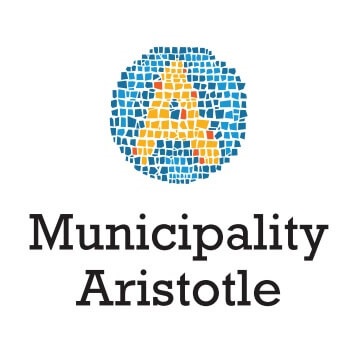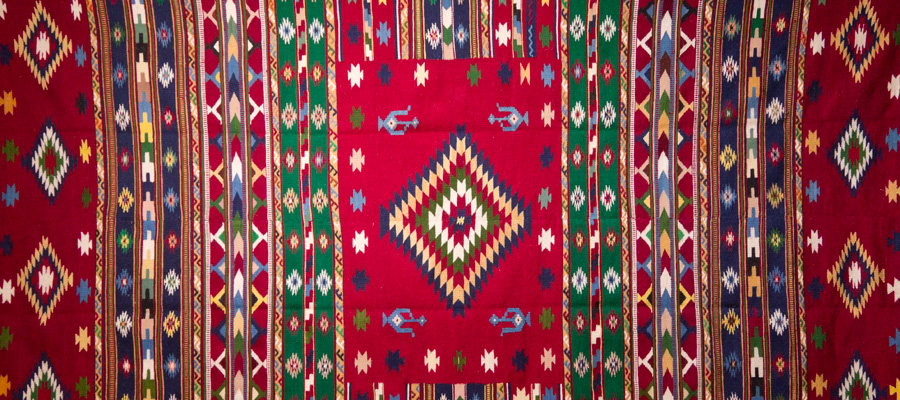In all the books about Halkidiki, you will find references to the handmade textiles made in various areas. Today, there may only be a few weavers left, but the craft does not disappear! The tradition of weaving was established long ago in Arnaia, and its textiles were famous and unique. Until 1930, weaving was thriving, and the fabrics or silks made were in high demand. The entire plain, from Gerakini to Kalyvia and Agios Mamas, was filled with mulberry trees (ascomi, from the ancient sycamore). There were female weavers, as well as male weavers and embroiderers who made the coarser clothes.
In Ouranoupoli, refugees brought the art of weaving carpets and oriental designs with them. Joice Loch helped the women experiment with new ways of dyeing threads from plant materials such as roots, peels, leaves, and insects, and her husband brought Byzantine designs and wall paintings from Mount Athos.
According to the oral testimony of one of the old weavers, Mrs. Sofia Isaacidou, who worked with Loch from 1951 onward, the women took work home or worked at the Pyrgos Prosforiou, and the couple would then sell their woven products. Up to 15-20 women were weaving in her time, and even more in the past. It would take 2-3 people about a month to finish a rug. They were paid per knot, and the money helped their families or bought dresses.
ARGALEIOS & WEAVING ART IN ARNAIA
* The loom and weaving art have had glorious pages in Arnaia. A tool essential in every household in the Greek countryside, and an art necessary for every housewife. With their hands and this tool, they had to clothe the entire family, weave the bedding of the house, and the covers for the family during the difficult and cold winter nights. There is no corner of Greece where the memories of the loom and this art are not still fresh.
In Arnaia, however, these memories and the art became a legend, marking and identifying the history of the place, with the “diassidi,” “stimoni,” “saita,” combs, spindles, rokes, lanaria, spindles, but primarily with the unique Arnaian bridal textiles. A dowry agreement that did not include an Arnaian rug or a wall band was considered “incomplete,” and the bride “poor.” There was no house without one or two looms, and no woman who did not know its secrets. Some of these weavers even wrote their own brilliant history.
The French consul of Thessaloniki, E. Cousinery, in his book “A Journey to Halkidiki in 1793” writes: “The prosperity in which the inhabitants of Liariakovi live does not only come from the cultivation of their fields. They make rugs (kilims) using the local wool. Almost all the families engage in this work, and the products of this craft reached and were sold as far as Romelia (ROMELIE) and especially in the monasteries.” N. Schinas, in his travel notes from 1887, mentions among other things about Liariakovi: “The men are mule drivers, beekeepers, grape growers, cattle breeders, while the women engage in the making of fine woolen rugs.”
Arnaia had transformed its weaving craft into a heavy industry for the area. The women wove intricate textiles, and the men traded them throughout Macedonia and beyond. Unique designs and patterns – with a name of origin, we could say today, Liariakovi (from the old name of Arnaia, Liariakovi) – adorned monasteries, houses, dowries, and mansions. Unique compositions such as the klonos, the krikela, the trandaf’lia, Minadenas, and masterpieces of high craftsmanship value like the sun’s chariot, the dance of the Muses, Greek bravery, the dance of the Souliotes (Zaloggo), the deer, the honey moon, the king of the desert, the shepherdess, the little monastery and many others, have written their own story in the place.
ASSOCIATIONS-UNIONS
The history of the loom and weaving art in Arnaia goes back in time. The inspired and wise hierarch of the place, the late Metropolitan Socrates Stavridis, with the insight and keen perception that characterized him, organized the women weavers into a union (1917). In 1946, the Rural Weaving Cooperative was founded, and a cooperative dyeing plant was established at the Plystario location.
In 1969, the Union of Craftsmen-Cottage Workers of Arnaia was established, and the active president, Mr. Giannis Kouloumbis, managed to make the products of the Arnaian loom known beyond the country’s borders. Until 1980, Arnaia exported various small textiles to Australia, Germany, America, Canada, and Sweden (mainly small bands, rugs, pillows, and flokati). For the first time, collaboration with state agencies (EOMMEX, EOT, and ATE) was made, and the weavers were given the opportunity to take low-interest loans (wool loans), while metal looms were distributed to all the weavers.
In 1985, with the help of EOMMEX, the Handicraft and Folk Art Product Promotion Cooperative was founded. However, industrialization and the opening of cheaper markets seriously harmed this profitable cottage industry of weaving, and today it is nearing complete extinction.
CHARIKLEIA DIMITRAKOUDI
A fortunate event for Arnaia in the 1990s was the presence of one of its last artist weavers, Mrs. Charikleia Dimitrakoudi, who, deeply in love with the loom and tradition, turned the ground floor of her house into a small museum of textiles and traditional objects. She selflessly welcomed and guided visitors and foreign tourists. In honor of this humble weaver, let us mentally follow her own narration:
“For us Arniotes, the woven fabric is our local identity. Tradition says that in the castle of Orias, historically located on Ayios Lias, the princess wove with golden thread and golden saita… In the past, women also worked with cotton. Skilled craftsmen, called ‘stivakhtaries,’ would bring the cotton, pound it, and the women would spin it into thread on the spindle for carpets and bands… We also worked with silk, from the silkworm to the cocoon and the silk thread, which we called ‘vrocho.’ We wove silk bedding and silk dresses. In fact, it was the first income the family would receive at the beginning of summer, called the ‘maxouli’… For us, the woven fabric was a necessity, it clothed the Arniote from birth to death. But we women, with passion and imagination, made it into a work of art, to decorate our homes and beautify our hard lives. Our textiles had names that reflected the technique of their creation (with the nail or thilotta), the material, the design, the color (such as khaki, etc.), or their use (mesali) for bread in the ‘pinakoti’ (trokhnia) for carrying the baby on the back, or their origin, Polygyro, Revenikiotiko, etc.”
These words come from her speech at the 1st Development Conference of Arnaia (July 21-22, 1990). Her speech was titled: “The Handmade Textile of Arnaia: How the Weavers of Arnaia See and Evaluate the Problem.” Along with her, and with them, the history of textiles, the loom, plant dyes, and the soul art of weaving disappeared.
THE FOUNDING OF THE WEAVING MUSEUM
In July 2009, her children decided to donate their mother’s soul, her legacy – the loom and her textiles – to the Municipality. This followed a programmatic agreement between the Prefecture (A. Zografos), the Municipality (L. Lazarou), and the Research Committee of AUTH for the utilization and transformation of the “Giannoudenas” mansion into a museum.
On November 1, 2010, during the local celebration of Saints Anargyroi, the inauguration of the Arnaia Weaving Museum took place, which is a gem for Arnaia, the wider Municipality of Aristotelis, and all of Halkidiki. Visitors can experience the grandeur of this art, tour its two floors, admire Mrs. Dimitrakoudi’s collection, read the handwritten recipes for plant dyes from her personal notebook, learn about the weaver’s equipment, hear the sounds of the loom and the swish of the saita, listen to songs related to the loom, and experience images of the past through the museum’s modern electronic equipment.
* Text: Asterios Th. Karastergios, Former Mayor of Arnaia, Former President of the Weaving Museum



